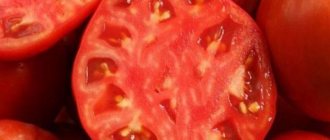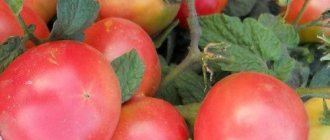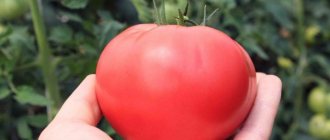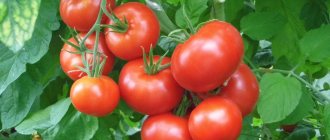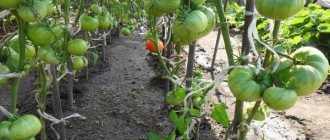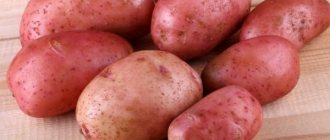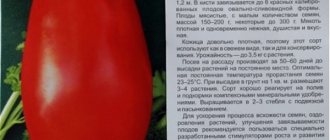The Wild Rose tomato variety is an excellent large-fruited variety, adapted for cultivation in a wide variety of regions. It is not afraid of extreme heat, temperature changes or insufficiently good soil. The harvest will invariably be rich and very tasty.
| Height | Landing location | Ripening time | Fruit color | Fruit size | Origin | Fruit shape |
| Tall | Greenhouse, Open ground | Mid-early | Pink | Large | Variety | Flat-round |
Wild Rose tomatoes: variety description
| Variety name | Wild Rose |
| general description | Mid-season indeterminate variety |
| Originator | Russia |
| Ripening period | 110-115 days |
| Form | Flat-rounded |
| Color | Pink |
| Average weight of tomatoes | 300-350 grams |
| Application | Table variety |
| Productivity of the variety | 6 kg per square meter |
| Features of cultivation | Standard agricultural technology |
| Disease resistance | Quite disease resistant |
The variety is of Russian origin, bred in 1999 and intended for cultivation in open ground and film greenhouses. Undemanding, tolerates temperature fluctuations calmly .
The collected fruits are well stored and transported. Tomatoes can be harvested in the technological ripeness phase; they ripen successfully at home. Wild Rose is a mid-early, high-yielding variety. Fruiting occurs 110-115 days after sowing the seeds . The bush is indeterminate, reaches 2 m in height and requires mandatory tying. Forms an abundant green mass and requires pinching.
The yield is quite high, from 1 sq. m you can harvest up to 6 kg of tomatoes .
Among the main advantages of the variety:
- high taste qualities of fruits;
- good yield;
- unpretentiousness, resistance to heat;
- It is possible to grow Wild Rose tomatoes in greenhouses and in open ground.
The main difficulty when growing is a very tall bush that needs to be tied to stakes or trellises.
You can compare the yield of this variety with others in the table:
| Variety name | Productivity |
| Wild Rose | 6 kg per square meter |
| American ribbed | 5.5 per bush |
| De Barao the Giant | 20-22 kg per bush |
| King of the market | 10-12 kg per square meter |
| Kostroma | 4.5-5 kg per bush |
| Summer resident | 4 kg per bush |
| Honey Heart | 8.5 kg per square meter |
| Banana Red | 3 kg per bush |
| Golden Jubilee | 15-20 kg per square meter |
| Diva | 8 kg per bush |
Characteristics
The fruits are large, round, slightly flattened. Tomatoes reach a weight of 300-350 g. During the ripening process, they change from spotty green to rich pink. The pulp is juicy, not watery, with a rich sour-sweet taste. The acidity is moderate, the sugar content reaches 3.7%, dry matter - up to 7%.
The fruits are recommended for salads and preparing hot dishes. Ripe tomatoes make delicious sauces, juices and purees.
You can compare the weight of the fruits of this variety with others in the table below:
| Variety name | Fruit weight |
| Wild Rose | 300-350 grams |
| Pickling miracle | 90 grams |
| Locomotive | 120-150 grams |
| President 2 | 300 grams |
| Leopold | 80-100 grams |
| Katyusha | 120-150 grams |
| Aphrodite F1 | 90-110 grams |
| Aurora F1 | 100-140 grams |
| Anyuta F1 | 95-120 grams |
| Boni M | 75-100 |
Photo
Tomatoes of the wild rose variety are quite large tomatoes, you can see this in the photo:
Use in cooking
The Wild Rose tomato is a universal variety. It can be used for preparing seasonal and winter salads, as well as for preparing first and second courses.
It is not suitable for preservation in its entirety due to its large size. But these tomatoes make good pasta and excellent sauces. The resulting tomato juice is thick, not brightly colored, but very pleasant to the taste.
Pink, juicy and tasty tomatoes are ideal for eating in their pure form.
Features of cultivation
Tomatoes are sown as seedlings in March; light, fertile soil is recommended for planting. A mixture of turf or garden soil with humus is recommended. Before planting, the soil must be calcined and spilled with a solution of potassium permanganate or copper sulfate.
Read more about soil for seedlings and for adult plants in greenhouses. We will tell you about what types of soil for tomatoes exist, how to prepare the right soil yourself, and how to prepare the soil in the greenhouse for planting in the spring.
The seeds are sown slightly deeper and sprinkled with a thin layer of peat. To speed up germination, the container is covered with film and placed in a warm place. After unfolding two true leaves, the seedlings are picked into separate pots and placed in bright light.
Young sprouts need warmth, periodic ventilation and moderate watering . After picking, the seedlings are fed with an aqueous solution of complex mineral fertilizer. Fertilizing is repeated before planting in the ground.
Transplantation into the greenhouse is carried out in mid-May. A little ash or complex fertilizer is poured into each hole. The distance between bushes is at least 60 cm . Thickening of plantings greatly reduces fruiting.
There are a huge number of ways to grow tomato seedlings. We bring to your attention a series of articles on how to do this:
- in twists;
- in two roots;
- in peat tablets;
- without picking;
- using Chinese technology;
- in bottles;
- in peat pots;
- without land.
Immediately after transplantation, young plants are tied to supports. A tall bush can be placed along a trellis, this will provide reliable support. It is better to remove the lower leaves; this will improve air exchange and insolation. It is recommended to form a bush with 1 or 2 stems, all stepsons are removed .
During the season, plants are fed with complete complex fertilizer, diluted mullein or bird droppings every 2 weeks. Watering should be moderate, after the top layer of soil dries slightly. The fruits are collected as they ripen.
Read on our website all about diseases of tomatoes in greenhouses and methods of combating these diseases. We also offer materials on high-yielding and disease-resistant varieties for your information.
Gardener mistakes
- Having set aside a poorly lit area for this variety, gardeners often end up with sour fruits. Only with an abundance of light do tomatoes acquire their best characteristics.
- Too dense a planting pattern and neglect of shaping leads to thickening of the beds, and this often ends in diseases and reduced yields.
- Excessive watering contributes to fungal diseases, especially if there is poor air circulation in the greenhouse. To control humidity, you need to focus on the condition of the soil, and after watering, ventilate the room and loosen the bed.
Diseases and pests
The variety of Russian selection is quite resistant to viral and fungal diseases. For prevention, it is recommended to annually change the top layer of soil in the greenhouse. Before filling in new soil, it must be disinfected by treating it with an aqueous solution of potassium permanganate. It is recommended to spray the plantings with a faint pink solution.
Pests are effectively removed by water with ammonia or soap solution. When processing, it is important to ensure that solutions do not get into the soil. Spider mites can be destroyed with insecticides, but they are used only before flowering begins. Mulching the soil with straw or peat will help protect you from slugs.
The Wild Rose tomato is a variety that is perfect for experienced gardeners who love experiments. The variety is also suitable for beginners who have skills in pinching. Wild rose tomatoes, as the description of the variety says, are undemanding, fruiting is plentiful, and the taste of the fruit will not leave anyone indifferent.
Reviews from those who planted
Peter
My wife and I bought seeds at a fair two seasons ago. They didn’t pay much attention to the packaging and manufacturer. The seeds did not germinate. As it turned out, we bought the missing seeds, some of which were empty. And that summer, we bought the seeds from a trusted store and after 3 months the seeds produced the first tomatoes: tasty and juicy, just what you need for any dish.
Alexei
I have been growing tomatoes Rose for several years now. I like the variety, it’s not whimsical, you don’t have to fuss with it. The tomatoes always turned out juicy, and so many of them ripened that some of them were taken for sale while still unripe. Last season the weather was cool and I decided to grow tomatoes in a greenhouse. I did everything the same as always, but some of the seedlings fell ill with late blight. The neighbor then pointed out the mistake - I did not ventilate the greenhouse. The stuffiness ruined the entire harvest. So be careful.
Angora decorative rabbit: description of the breed, care, maintenance and feeding
Tomato Rose is a godsend for both novice and experienced gardeners. If all conditions are met, you can easily enjoy the results of your labor in just a few months: fragrant, juicy Rose tomatoes that will delight not only you, but the whole family.
Video
The Wild Rose tomato variety can be seen more visually in the video:
| Super early | Mid-early | Late ripening |
| Alpha | King of the Giants | Premier |
| Pickling miracle | Supermodel | Grapefruit |
| Labrador | Budenovka | Yusupovsky |
| Bullfinch | Bear Paw | Rocket |
| Solerosso | Danko | Digitomandra |
| Debut | King Penguin | Rocket |
| Alenka | emerald apple | Snowfall F1 |
If you find an error, please select a piece of text and press Ctrl+Enter.
